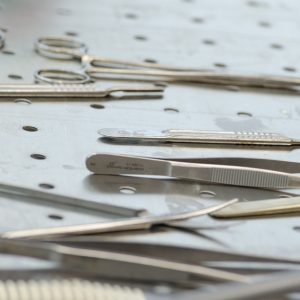
Scarring hair loss, or cicatricial alopecia, is a form of permanent hair loss whereby hair follicles are destroyed and replaced with scar tissue5. There are many conditions which can lead to scarring hair loss such as dissecting cellulitis, eosinophilic pustular folliculitis, follicular degeneration syndrome, folliculitis decalvans, lichen planopilaris and pseudopelade of Brocq as well as isolated events including trauma, burns, infection, radiation or surgery. Non-surgical treatment options aim to halt further hair loss and relieve signs and symptoms of disease. Unfortunately once the follicles are lost, there are few treatment options to restore hair outside of surgery.
Nonetheless, treating scarring alopecia through a hair transplant can be tricky for multiple reasons. One of which is the reduced blood flow in the affected areas. The remaining scar tissue may impede blood flow to any new transplanted follicles resulting in insufficient nutrients to stimulate hair growth2. Scarring can also affect the donor area, greatly reducing the number of potential grafts1.
Platelet-rich plasma (PRP), or as we like to call it here the vampire treatment, is a relatively new treatment option which can be used in combination with hair surgery. A small amount of your own blood is extracted. The portion of blood which contains an abundance of growth factors is then injected back, directly into your scalp.
These growth factors are known to both encourage the development of new blood vessels3 as well as increase the number of surviving transplanted hair follicles4 therefore potentially improving both issues of reduced blood flow and donor grafts.
A recent case study describes a 24-year-old male with lichen planopilaris who was treated with a combination of PRP and FUE surgery1. An 80% survival rate of transplanted follicles was reported leading to reasonable coverage, despite what was described as extensive alopecia. There have not been many similar cases reported as of yet, but PRP is rapidly gaining popularity in the hair restoration industry.
Overall, there are multiple treatment options, including hair surgery, available for scarring hair loss. Generally, hair a surgical solution should not be considered if the disease process has not been stable for at least two years. If you are concerned about the appearance of your scarring hair loss, book a consultation with a hair restoration expert to help assess your individual situation.
Article by: Dr. J.L. Carviel, PhD, Mediprobe Research Inc.
References
- Saxena K, Saxena DK, Savant SS. Successful Hair Transplant Outcome in Cicatricial Lichen Planus of the Scalp by Combining Scalp and Beard Hair Along With Platelet Rich Plasma. J Cutan Aesthetic Surg. 2016 Mar;9(1):51–5.
- Unger W, Unger R, Wesley C. The surgical treatment of cicatricial alopecia. Dermatol Ther. 2008 Aug;21(4):295–311.
- Li ZJ, Choi H-I, Choi D-K, Sohn K-C, Im M, Seo Y-J, et al. Autologous platelet-rich plasma: a potential therapeutic tool for promoting hair growth. Dermatol Surg Off Publ Am Soc Dermatol Surg Al. 2012 Jul;38(7 Pt 1):1040–6.
- Uebel CO, da Silva JB, Cantarelli D, Martins P. The role of platelet plasma growth factors in male pattern baldness surgery. Plast Reconstr Surg. 2006 Nov;118(6):1458–66; discussion 1467.
- Siah TW, Shapiro J. Scarring alopecias: a trichologic emergency. Semin Cutan Med Surg. 2015 Jun;34(2):76–80.












